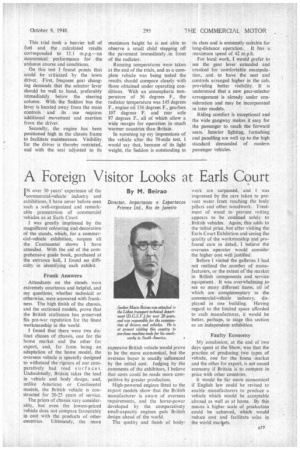A Foreign Visitor Looks at Earls Court
Page 71

If you've noticed an error in this article please click here to report it so we can fix it.
By M. Beirao
IN over 30 years' experience of the Icommercial-vehicle industry and exhibitions, I have never before seen such a ,well-organized and remarkable presentation of .commercial vehicles as at Earls Court
I was greatly impressed by the magnificent colouring and decoration of the stands, which, for a commercial-vehicle exhibition, surpass all the Continental shows I have attended. With the aid of the cornprehensive guide book, purchased at the entrance hall, I found no difficulty in identifying each exhibit.
Frank Answers Attendants on the stands were extremely courteous and helpful, and my questions, whether technical or 'otherwise, were answered with frankness. The high finish of the chassis, and the sectioned models, prove that the British craftsman has preserved his pre-war reputation for the finest workmanship in the world.
I found that there were two distinct classes of chassis, one for the home market and the other for export, and, far from being an adaptation of the home model, the overseas vehicle is specially designed to withstand the rigours of our comparatively bad road surface s. Undoubtedly, Britain takes the lead in vehicle and body design, and, unlike American or Continental models, the British vehicle is constructed for 20-25 years of service.
The prices of chassis vary considerably, but even the lowest-priced vehicle does not compare favourably in cost with the products of other countries. Ultimately, the more expensive British vehicle would prove to be the more economical, but the overseas buyer is usually influenced by the initial cost. Judging by the comments of the exhibitors, I believe that costs could be made more competitive by greater production.
High-powered engines fitted to the export models show, that the British manufacturer is aware of overseas requirements, and the horse-power developed by the comparatively small-capacity engines puts British design ahead of the world.
The quality and finish of body
work are surpassed, and I was impressed by the care taken to prevent water from reaching the body pillars and other woodwork. Treatment of wood to prevent rotting appears to be confined solely to British vehicles. Again, this adds to the initial price, but after visiting the Earls Court Exhibition and seeing the quality of the workmanship and profound care in detail, I believe the overseas operator would consider the higher cost well justified.
Before I visited the galleries I had not realized the .number of _manufacturers, or the extent of the market in British components and service equipment. It was overwhelming to see so many different items, all of which are complementary to the commercial-vehicle industry, displayed in one building. Having regard to the limited space afforded to each manufacturer, it would be better, perhaps, to stage this section as art independent exhibition.
Faulty Economy My conclusion, at the end of two days spent at the Show, was that the practice of producing two types of vehicle, one for the home market and the other for export, is not sound economy if Britain is to compete in price with other countries.
ft would be• far more economical if English law could be revised to enable manufacturers to produce a vehicle which would be acceptable abroad as well as at home. By this means 'a higher scale of production could be achieved, which would reduce cost and facilitate sales in the world marliets.




















































































































